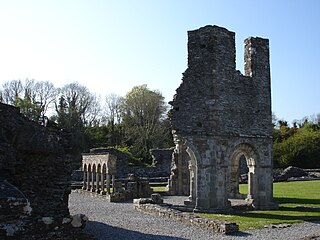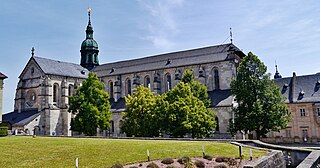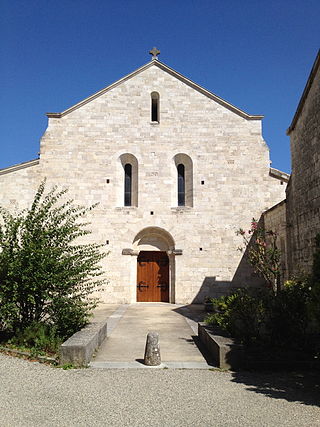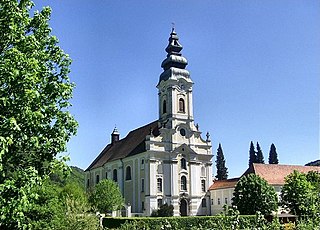
Cîteaux Abbey is a Catholic abbey located in Saint-Nicolas-lès-Cîteaux, south of Dijon, France. It is notable for being the original house of the Order of Cistercians. Today, it belongs to the Trappists.
Adam of Ebrach was a Cistercian monk and the first abbot of Ebrach Abbey in the area of Bamberg, Bavaria, Germany, and later the founding abbot of Langheim Abbey.

The Abbey of Our Lady of Gethsemani is a Catholic monastery in the United States near Bardstown, Kentucky, in Nelson County. The abbey is part of the Order of Cistercians of the Strict Observance, better known as the Trappists. Founded on December 21, 1848, and raised to an abbey in 1851, Gethsemani is considered to be the motherhouse of all Trappist and Trappistine monasteries in the United States. Gethsemani is the oldest Trappist monastery in the country that is still operating.

Mellifont Abbey, was a Cistercian abbey located close to Drogheda in County Louth, Ireland. It was the first abbey of the order to be built in Ireland. In 1152, it hosted the Synod of Kells-Mellifont. After its dissolution in 1539, the abbey became a private manor house. This saw the signing of the Treaty of Mellifont in 1603 and served as William of Orange's headquarters in 1690 during the Battle of the Boyne.

Val-Dieu Abbey is a former Cistercian monastery in Wallonia in the Berwinne valley near Aubel in the Pays de Herve.

The Abbey of Notre-Dame des Neiges or Our Lady of the Snows is a Cistercian monastery in the Ardèche département of south-central France. The former Trappist monastery has been resettled by Cistercian nuns in 2022. The abbey was built in 1850, located on the territory of the commune of Saint-Laurent-les-Bains, about one and a half miles east of the village of La Bastide-Puylaurent (Lozère).

Ebrach Abbey is a former Cistercian monastery in Ebrach in Oberfranken, Bavaria, Germany, now used as a young offenders' institution.

Aiguebelle Abbey is a Trappist monastery situated in the communes of Montjoyer and Réauville in the département of Drôme, on the borders of the Dauphiné and of Provence, France.

Sept-Fons Abbey, Notre-Dame de Sept-Fons or Notre-Dame de Saint-Lieu Sept-Fons is a Trappist monastery at Diou in Bourbonnais in the diocese of Moulins in France. Around ninety monks currently live in the monastery, many of whom are novices sent from monasteries around the world.

Theobald of Marly was a French abbot and saint. He was born at the castle of Marly, Montmorency, and was trained as a knight. He served as a knight at the court of Philip Augustus, though he later entered the Cistercian monastery of Vaux-de-Cernay in 1220. He was elected prior in 1230 and ninth abbot in 1235.

Grandselve Abbey was a Cistercian monastery in south-west France, at Bouillac, Tarn-et-Garonne. It was one of the most important Cistercian abbeys in the south of France.

Vaux-de-Cernay Abbey is a former Cistercian monastery in northern France (Île-de-France), situated in Cernay-la-Ville, in the Diocese of Versailles, Yvelines. The abbey was abandoned during the French Revolution and fell into partial ruin. Most of the buildings, except for the church, were restored in the late 19th century by Charlotte de Rothschild, and the property is now a hotel.

Engelszell Abbey was the last Trappist monastery in Austria. It is located near Engelhartszell an der Donau in the Innviertel in Upper Austria.

The Feuillants were a Catholic congregation originating in the 1570s as a reform group within the Cistercians in its namesake Les Feuillants Abbey in France, which declared itself an independent order.

Vendel Endrédy O.Cist. was a Hungarian monk, and the abbot of Zirc, Pilis-Paszto and St. Gotthard abbeys and abbot president of the Zirc Congregation 1939–1981.

Igny Abbey or Val d'Igny Abbey is a Cistercian abbey located in Arcis-le-Ponsart, Marne, France. It was founded in 1128 for Cistercian monks, dissolved in 1791 during the French Revolution, re-established in 1876 for Trappist monks, destroyed in 1918, reopened in 1929 for Trappist nuns and modernised in 2008–12 to accommodate three or four pre-existing communities.

The Abbey of Our Lady of Atlas is a Catholic monastery of Trappists, inaugurated on March 7, 1938, in Tibhirine, close to Médéa, in Algeria.

Rawaseneng Monastery is a monastery complex of the Catholic Order of Cistercians of the Strict Observance (O.C.S.O.), popularly known as the Trappists, located in Temanggung Regency, Central Java, Indonesia. The monastery was officially established on 1 April 1953 as a daughter house of Koningshoeven Abbey in Tilburg, Netherlands. Apart from being a residence for the monks, there are also a church, prayer garden, retreat houses, coffee plantations, dairy farms along with the processing industries within the monastery complex. Ronald Bell, a pilgrim from the United States, shares his impression about this place, "You will get all the stages, praying, meditating, contemplating sacred readings, and working. All of those constitute an inseparable part of the experience." Not far from the monastery complex, it lies the Church of Santa Maria dan Yoseph as the center of the Rawaseneng Parish, just ahead of the Kindergarten and Elementary School of Fatima Rawaseneng which are managed by the Dominican nuns.

Altbronn Abbey or Our Lady of Mercy Abbey is a former Trappistine nunnery in Ergersheim, Bas-Rhin, northeastern France.
Nicolas I Boucherat was Abbot of Cîteaux 1571-1583/84 and thereby Abbot General of the Cistercian Order.





















